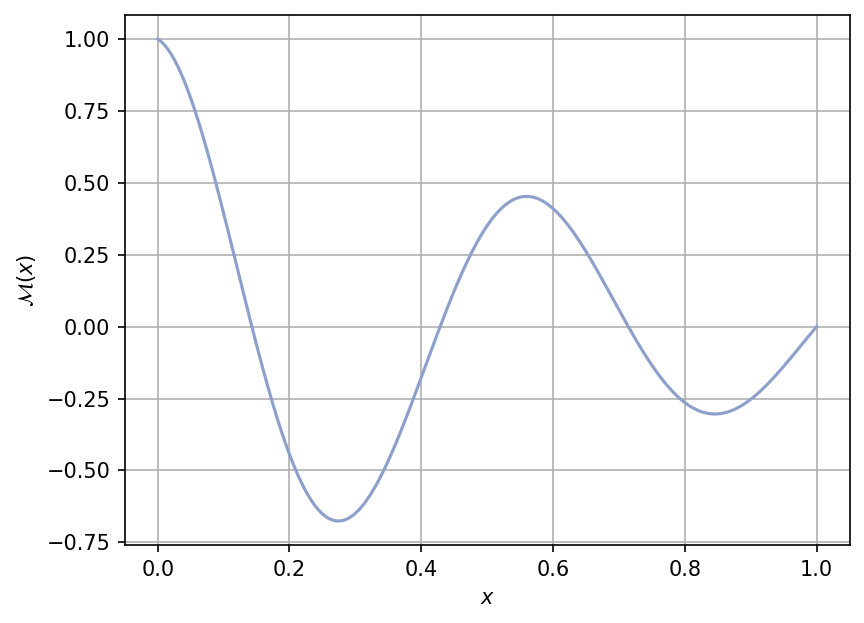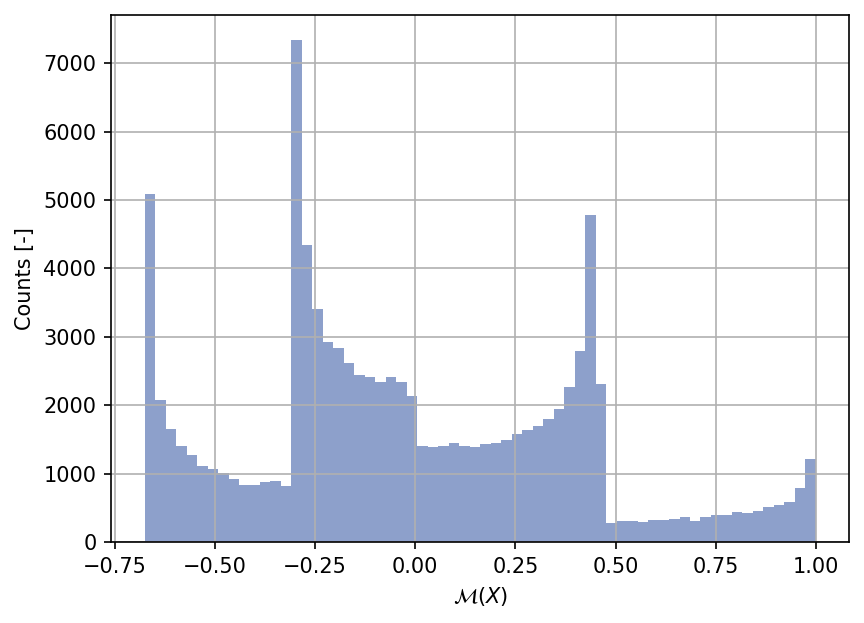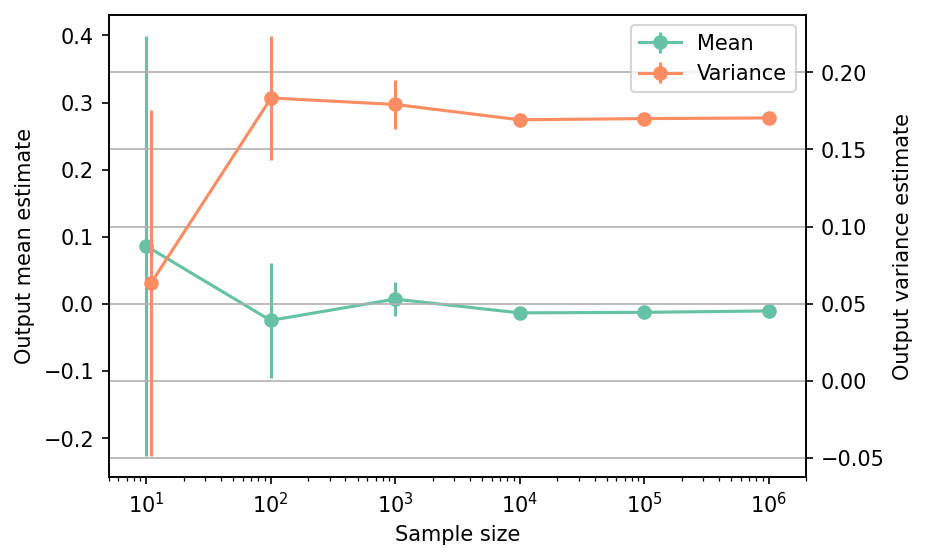One-dimensional (1D) Damped Cosine Function
Contents
One-dimensional (1D) Damped Cosine Function#
The 1D damped cosine function from Santner et al. [SWN18] is a scalar-valued test function for metamodeling exercises.
import numpy as np
import matplotlib.pyplot as plt
import uqtestfuns as uqtf
A plot of the function is shown below for \(x \in [0, 1]\).

Test function instance#
To create a default instance of the test function:
my_testfun = uqtf.DampedCosine()
Check if it has been correctly instantiated:
print(my_testfun)
Name : DampedCosine
Spatial dimension : 1
Description : One-dimensional damped cosine from Santner et al. (2018)
Description#
The test function is analytically defined as follows1:
where \(x\) is defined below.
Probabilistic input#
Based on [SWN18], the domain of the function is in \([0, 1]\). In UQTestFuns, this domain can be represented as a probabilistic input model using the uniform distribution shown in the table below.
my_testfun.prob_input
Name: Santner2018
Spatial Dimension: 1
Description: Input model for the one-dimensional damped cosine from Santner et al. (2018)
Marginals:
| No. | Name | Distribution | Parameters | Description |
|---|---|---|---|---|
| 1 | x | uniform | [0. 1.] | None |
Copulas: None
Reference results#
This section provides several reference results of typical UQ analyses involving the test function.
Sample histogram#
Shown below is the histogram of the output based on \(100'000\) random points:
np.random.seed(42)
xx_test = my_testfun.prob_input.get_sample(100000)
yy_test = my_testfun(xx_test)
plt.hist(yy_test, bins="auto", color="#8da0cb");
plt.grid();
plt.ylabel("Counts [-]");
plt.xlabel("$\mathcal{M}(X)$");
plt.gcf().tight_layout(pad=3.0)
plt.gcf().set_dpi(150);

Moment estimations#
Shown below is the convergence of a direct Monte-Carlo estimation of the output mean and variance with increasing sample sizes.
np.random.seed(42)
sample_sizes = np.array([1e1, 1e2, 1e3, 1e4, 1e5, 1e6], dtype=int)
mean_estimates = np.empty((len(sample_sizes), 50))
var_estimates = np.empty((len(sample_sizes), 50))
for i, sample_size in enumerate(sample_sizes):
for j in range(50):
xx_test = my_testfun.prob_input.get_sample(sample_size)
yy_test = my_testfun(xx_test)
mean_estimates[i, j] = np.mean(yy_test)
var_estimates[i, j] = np.var(yy_test)
# --- Compute the error associated with the estimates
mean_estimates_errors = np.std(mean_estimates, axis=1)
var_estimates_errors = np.std(var_estimates, axis=1)
# --- Plot the mean and variance estimates
fig, ax_1 = plt.subplots(figsize=(6,4))
# --- Mean plot
ax_1.errorbar(
sample_sizes,
mean_estimates[:,0],
yerr=2.0*mean_estimates_errors,
marker="o",
color="#66c2a5",
label="Mean"
)
ax_1.set_xlim([5, 2e6])
ax_1.set_xlabel("Sample size")
ax_1.set_ylabel("Output mean estimate")
ax_1.set_xscale("log");
ax_2 = ax_1.twinx()
# --- Variance plot
ax_2.errorbar(
sample_sizes+1,
var_estimates[:,0],
yerr=1.96*var_estimates_errors,
marker="o",
color="#fc8d62",
label="Variance",
)
ax_2.set_ylabel("Output variance estimate")
# Add the two plots together to have a common legend
ln_1, labels_1 = ax_1.get_legend_handles_labels()
ln_2, labels_2 = ax_2.get_legend_handles_labels()
ax_2.legend(ln_1 + ln_2, labels_1 + labels_2, loc=0)
plt.grid()
fig.set_dpi(150)

The tabulated results for each sample size is shown below.
from tabulate import tabulate
# --- Compile data row-wise
outputs =[]
for (
sample_size,
mean_estimate,
mean_estimate_error,
var_estimate,
var_estimate_error,
) in zip(
sample_sizes,
mean_estimates[:,0],
2.0*mean_estimates_errors,
var_estimates[:,0],
2.0*var_estimates_errors,
):
outputs += [
[
sample_size,
mean_estimate,
mean_estimate_error,
var_estimate,
var_estimate_error,
"Monte-Carlo",
],
]
header_names = [
"Sample size",
"Mean",
"Mean error",
"Variance",
"Variance error",
"Remark",
]
tabulate(
outputs,
numalign="center",
stralign="center",
tablefmt="html",
floatfmt=(".1e", ".4e", ".4e", ".4e", ".4e", "s"),
headers=header_names
)
| Sample size | Mean | Mean error | Variance | Variance error | Remark |
|---|---|---|---|---|---|
| 1.0e+01 | 8.6711e-02 | 3.1261e-01 | 6.3458e-02 | 1.1457e-01 | Monte-Carlo |
| 1.0e+02 | -2.4230e-02 | 8.5381e-02 | 1.8342e-01 | 4.1111e-02 | Monte-Carlo |
| 1.0e+03 | 7.4678e-03 | 2.5631e-02 | 1.7922e-01 | 1.6246e-02 | Monte-Carlo |
| 1.0e+04 | -1.3006e-02 | 8.1933e-03 | 1.6927e-01 | 3.9006e-03 | Monte-Carlo |
| 1.0e+05 | -1.2232e-02 | 2.6456e-03 | 1.7003e-01 | 1.2400e-03 | Monte-Carlo |
| 1.0e+06 | -1.0106e-02 | 7.8064e-04 | 1.7047e-01 | 4.2654e-04 | Monte-Carlo |
References#
- SWN18(1,2,3)
Thomas J. Santner, Brian J. Williams, and William I. Notz. The design and analysis of computer experiments. Springer New York, 2018. doi:10.1007/978-1-4939-8847-1.

